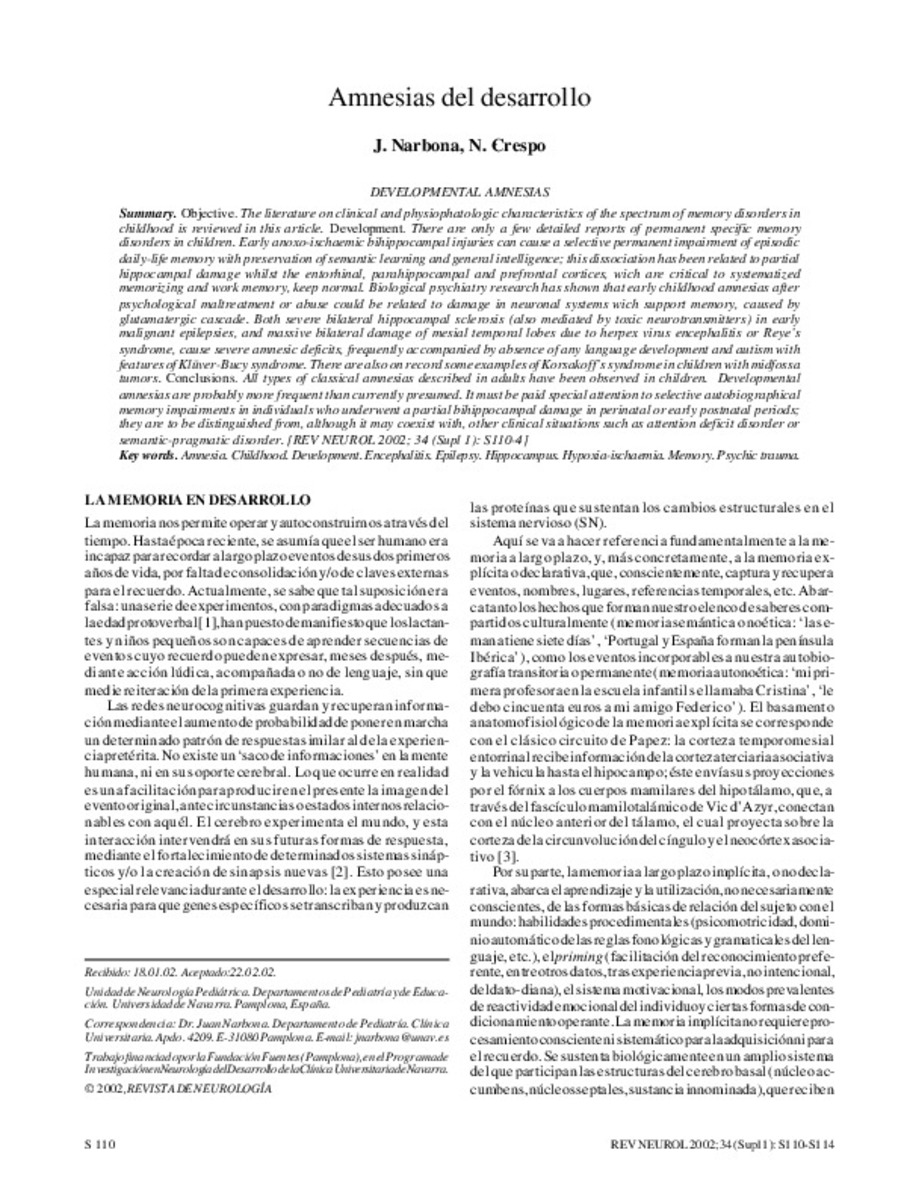Full metadata record
| DC Field | Value | Language |
|---|---|---|
| dc.creator | Crespo-Eguilaz, N. (Nerea) | - |
| dc.creator | Narbona, J. (Juan) | - |
| dc.date.accessioned | 2019-07-10T06:24:19Z | - |
| dc.date.available | 2019-07-10T06:24:19Z | - |
| dc.date.issued | 2002 | - |
| dc.identifier.citation | Crespo-Eguilaz, N. (Nerea); Narbona, J. (Juan). "Amnesias del desarrollo". Revista de neurología. 34 (1), 2002, 110 - 114 | es |
| dc.identifier.issn | 0210-0010 | - |
| dc.identifier.uri | https://hdl.handle.net/10171/57957 | - |
| dc.description.abstract | Objective. The literature on clinical and physiophatologic characteristics of the spectrum of memory disorders in childhood is reviewed in this article. Development. There are only a few detailed reports of permanent specific memory disorders in children. Early anoxo-ischaemic bihippocampal injuries can cause a selective permanent impairment of episodic daily-life memory with preservation of semantic learning and general intelligence; this dissociation has been related to partial hippocampal damage whilst the entorhinal, parahippocampal and prefrontal cortices, wich are critical to systematized memorizing and work memory, keep normal. Biological psychiatry research has shown that early childhood amnesias after psychological maltreatment or abuse could be related to damage in neuronal systems wich support memory, caused by glutamatergic cascade. Both severe bilateral hippocampal sclerosis (also mediated by toxic neurotransmitters) in early malignant epilepsies, and massive bilateral damage of mesial temporal lobes due to herpex virus encephalitis or Reye’s syndrome, cause severe amnesic deficits, frequently accompanied by absence of any language development and autism with features of Klüver-Bucy syndrome. There are also on record some examples of Korsakoff’s syndrome in children with midfossa tumors. Conclusions. All types of classical amnesias described in adults have been observed in children. Developmental amnesias are probably more frequent than currently presumed. It must be paid special attention to selective autobiographical memory impairments in individuals who underwent a partial bihippocampal damage in perinatal or early postnatal periods; they are to be distinguished from, although it may coexist with, other clinical situations such as attention deficit disorder or semantic-pragmatic disorder. | es_ES |
| dc.description.sponsorship | Trabajo financiado por la Fundación Fuentes (Pamplona), en el Programa de Investigación en Neurología del Desarrollo de la Clínica Universitaria de Navarra. | es_ES |
| dc.language.iso | spa | es_ES |
| dc.publisher | Viguera editores | es_ES |
| dc.rights | info:eu-repo/semantics/openAccess | es_ES |
| dc.subject | Amnesia | es_ES |
| dc.subject | Childhood | es_ES |
| dc.subject | Development | es_ES |
| dc.subject | Encephalitis | es_ES |
| dc.subject | Epilepsy | es_ES |
| dc.subject | Hippocampus | es_ES |
| dc.subject | Hypoxia-ischaemia | es_ES |
| dc.subject | Memory | es_ES |
| dc.subject | Psychic trauma | es_ES |
| dc.title | Amnesias del desarrollo | es_ES |
| dc.title.alternative | Developmental amnesias | es_ES |
| dc.type | info:eu-repo/semantics/article | es_ES |
| dc.identifier.doi | 10.33588/rn.34S1.2002030 | - |
| dc.identifier.doi | https://doi.org/10.33588/rn.34S1.2002030 | es_ES |
| dadun.citation.endingPage | 114 | es_ES |
| dadun.citation.number | 1 | es_ES |
| dadun.citation.publicationName | Revista de neurología | es_ES |
| dadun.citation.startingPage | 110 | es_ES |
| dadun.citation.volume | 34 | es_ES |
Files in This Item:
Statistics and impact
Items in Dadun are protected by copyright, with all rights reserved, unless otherwise indicated.






